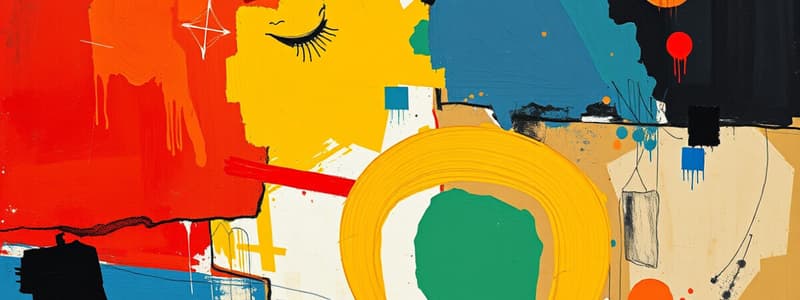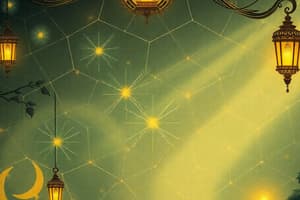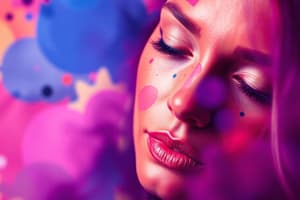Podcast
Questions and Answers
What does the concept of mimesis primarily relate to in art?
What does the concept of mimesis primarily relate to in art?
- The social conditions of the community
- The imitation of natural beauty (correct)
- The unique emotions of the artist
- The technological advancements in art
According to Leo Tolstoy, how does art convey emotions?
According to Leo Tolstoy, how does art convey emotions?
- By altering the truth of experiences
- Through abstract concepts
- Via external signs that affect others (correct)
- Through a focus on cultural style
How does Heidegger interpret the role of art in relation to culture?
How does Heidegger interpret the role of art in relation to culture?
- As a method to challenge historical norms
- As a mere reflection of technological progress
- As a way to articulate cultural truths (correct)
- As an expression of personal individualism
Which of the following best exemplifies art as a form of expression?
Which of the following best exemplifies art as a form of expression?
What effect did the public art project have in the city according to the provided content?
What effect did the public art project have in the city according to the provided content?
What is one of Karl Marx's views on art?
What is one of Karl Marx's views on art?
Which of the following does not represent a view associated with Heidegger's interpretation of art?
Which of the following does not represent a view associated with Heidegger's interpretation of art?
What was the broader aim of art according to Karl Marx's ideology?
What was the broader aim of art according to Karl Marx's ideology?
What is a common characteristic of Medieval Art?
What is a common characteristic of Medieval Art?
Which artist is NOT associated with the Renaissance period?
Which artist is NOT associated with the Renaissance period?
What is a defining feature of Cubism?
What is a defining feature of Cubism?
Which influential work is attributed to the Romanticism movement?
Which influential work is attributed to the Romanticism movement?
What artistic movement is characterized by spontaneity and improvisation?
What artistic movement is characterized by spontaneity and improvisation?
Which of the following artists is known for his work in the Baroque period?
Which of the following artists is known for his work in the Baroque period?
What is a characteristic feature of Rococo art?
What is a characteristic feature of Rococo art?
Which work is an example of Impressionism?
Which work is an example of Impressionism?
What was a key feature of Neoclassicism?
What was a key feature of Neoclassicism?
Which of these artists is associated with Expressionism?
Which of these artists is associated with Expressionism?
What is a characteristic of Art Nouveau?
What is a characteristic of Art Nouveau?
Which movement emphasizes the use of everyday objects?
Which movement emphasizes the use of everyday objects?
What did Conceptual Art prioritize over visual aesthetics?
What did Conceptual Art prioritize over visual aesthetics?
Which characteristic is typical of Fauvism?
Which characteristic is typical of Fauvism?
What is the concept of mimesis in art as described by Plato and Aristotle?
What is the concept of mimesis in art as described by Plato and Aristotle?
Which of the following illustrates the social function of art?
Which of the following illustrates the social function of art?
According to John Dewey's perspective, art is primarily characterized as what?
According to John Dewey's perspective, art is primarily characterized as what?
What distinguishes personal functions of art from physical functions?
What distinguishes personal functions of art from physical functions?
Which of the following is NOT true about the universality of art?
Which of the following is NOT true about the universality of art?
Which example best illustrates the physical function of art?
Which example best illustrates the physical function of art?
What aspect of art does the statement 'art is not nature' highlight?
What aspect of art does the statement 'art is not nature' highlight?
What is one key purpose of the Greek epics 'Iliad' and 'Odyssey' in the context of art?
What is one key purpose of the Greek epics 'Iliad' and 'Odyssey' in the context of art?
Flashcards
Prehistoric Art
Prehistoric Art
Early human expressions through rock carvings, sculptures, and cave paintings.
Ancient Art
Ancient Art
Art with religious and mythological imagery, serving decorative functions in civilizations like Mesopotamia and Egypt.
Medieval Art
Medieval Art
Biblical themes and classical mythology dominate this dark-imaged, religious art era.
Renaissance Art
Renaissance Art
Signup and view all the flashcards
Mannerism
Mannerism
Signup and view all the flashcards
Baroque
Baroque
Signup and view all the flashcards
Rococo
Rococo
Signup and view all the flashcards
Neoclassicism
Neoclassicism
Signup and view all the flashcards
Romanticism
Romanticism
Signup and view all the flashcards
Realism
Realism
Signup and view all the flashcards
Art Nouveau
Art Nouveau
Signup and view all the flashcards
Impressionism
Impressionism
Signup and view all the flashcards
Post-Impressionism
Post-Impressionism
Signup and view all the flashcards
Fauvism
Fauvism
Signup and view all the flashcards
Expressionism
Expressionism
Signup and view all the flashcards
Cubism
Cubism
Signup and view all the flashcards
Surrealism
Surrealism
Signup and view all the flashcards
Abstract Expressionism
Abstract Expressionism
Signup and view all the flashcards
Op Art
Op Art
Signup and view all the flashcards
Pop Art
Pop Art
Signup and view all the flashcards
Arte Povera
Arte Povera
Signup and view all the flashcards
Minimalism
Minimalism
Signup and view all the flashcards
Conceptual Art
Conceptual Art
Signup and view all the flashcards
Contemporary Art
Contemporary Art
Signup and view all the flashcards
Art is Universal
Art is Universal
Signup and view all the flashcards
Art is Not Nature
Art is Not Nature
Signup and view all the flashcards
Art Involves Experience
Art Involves Experience
Signup and view all the flashcards
Physical Functions
Physical Functions
Signup and view all the flashcards
Social Functions
Social Functions
Signup and view all the flashcards
Personal Functions
Personal Functions
Signup and view all the flashcards
Study Notes
The Evolution of Art
-
Prehistoric Art (~40,000–4,000 B.C.)
- Featured rock carvings, sculptures, and cave paintings.
- Notable work: Lascaux cave paintings in France, showcasing early human expression.
-
Ancient Art (4,000 B.C.–A.D. 400)
- Characterized by religious and mythological imagery, with decorative functions.
- Major civilizations: Mesopotamia, Egypt, Greece, Americas.
- Influential work: Code of Hammurabi, a significant artifact in legal history.
-
Medieval Art (500–1400)
- Dark imagery focused on biblical themes and classical mythology.
- Important figures: Abbot Suger, Cimabue, Giotto.
- Notable works: Cimabue's Crucifix (1288), Giotto's Lamentation of Christ (1305), Notre Dame Cathedral (1163–1345).
-
Renaissance Art (1400–1600)
- Emphasized realism, individualism, and detailed anatomy.
- Key artists: Leonardo da Vinci, Michelangelo, Raphael.
- Significant works: Da Vinci's Mona Lisa (1503), Michelangelo's David (1504), Raphael's The School of Athens (1511).
-
Mannerism (1527–1580)
- Known for stylization and exaggerated details.
- Contributors: Bronzino, Francesco Salviati, Giorgio Vasari.
- Example: Bronzino's Venus, Cupid, Folly and Time (1540).
-
Baroque (1600–1750)
- Distinguished by ornate grandeur and dramatic qualities.
- Prominent artists: Caravaggio, Rembrandt, Vermeer.
- Influential pieces: Caravaggio's The Calling of St Matthew (1600), Rembrandt's The Night Watch (1642).
-
Rococo (1699–1780)
- Characterized by elegance, lightness, and natural forms.
- Leading figures: Antoine Watteau, François Boucher.
- Key works: Watteau's Embarkation for Cythera (1718).
-
Neoclassicism (1750–1850)
- Revived classical antiquity with harmony and simplicity.
- Principal artists: Antonio Canova, Jacques-Louis David.
- Notable works: David's Napoleon Crossing the Alps (1801), Canova's The Three Graces (1816).
-
Romanticism (1780–1850)
- Focused on emotion, individual experience, and imagination.
- Notable contributors: Goya, Fuseli, Blake.
- Key pieces: Fuseli's The Nightmare (1781).
-
Realism (1848–1900)
- Detailed portrayals of everyday life.
- Leading artists: Gustave Courbet, Jean-François Millet.
- Influential works: Millet's The Gleaners (1857), Courbet's Woman with a Parrot (1866).
-
Art Nouveau (1890–1910)
- Features sinuous lines and organic forms.
- Key figures: Alphonse Mucha, Antoni Gaudí.
- Significant works: Gaudí's Church of Sagrada Familia (1882).
-
Impressionism (1865–1885)
- Characterized by quick brushstrokes and modern subjects.
- Leading artists: Claude Monet, Pierre-Auguste Renoir.
- Example works: Renoir's Dance in the City (1872), Monet's Impression, Sunrise (1899).
-
Post-Impressionism (1885–1910)
- Focused on symbolism and subjective experiences.
- Major contributors: Georges Seurat, Vincent van Gogh.
- Key pieces: Seurat's A Sunday Afternoon on the Island of La Grande Jatte (1886).
-
Fauvism (1900–1935)
- Known for bold colors and flat composition.
- Leading figures: André Derain, Henri Matisse.
- Popular works: Matisse's Woman with a Hat (1905).
-
Expressionism (1905–1920)
- Featuring distortion and emotional intensity.
- Notable artists: Edvard Munch, Wassily Kandinsky.
- Important pieces: Munch's The Dance of Life (1900).
-
Cubism (1907–1914)
- Characterized by geometric shapes and multiple perspectives.
- Key artists: Georges Braque, Pablo Picasso.
- Influential works: Braque's Violin and Palette (1909), Picasso's Guernica (1937).
-
Surrealism (1916–1950)
- Explored dreams and the unconscious mind.
- Major figures: Salvador Dalí, Max Ernst, René Magritte.
- Key works: Dalí's The Persistence of Memory (1931).
-
Abstract Expressionism (1940s–1950s)
- Known for spontaneous and large-scale works.
- Leading figures: Jackson Pollock, Mark Rothko.
- Significant works: Pollock's Autumn Rhythm (Number 30) (1950).
-
Op Art (1950s–1960s)
- Utilized visual effects through colors and patterns.
- Leading artists: Bridget Riley, Victor Vasarely.
- Notable works: Riley's Blaze (1964).
-
Pop Art (1950s–1960s)
- Used mass media and consumer culture imagery.
- Major artists: Andy Warhol, Roy Lichtenstein.
- Influential works: Warhol's Campbell's Soup Cans (1962).
-
Arte Povera (1960s)
- Emphasized natural materials in art practices.
- Key contributors: Alighiero Boetti, Mario Merz.
- Example: Merz's Giap’s Igloo (1968).
-
Minimalism (1960s–1970s)
- Focused on simplicity and the essence of art.
- Leading figures: Frank Stella, Donald Judd.
- Key works: Stella's Black Series I (1967).
-
Conceptual Art (1960s–1970s)
- Centered on ideas over aesthetic value.
- Major artists: Joseph Kosuth, Marcel Duchamp.
- Notable works: Kosuth's One and Three Chairs (1965).
-
Contemporary Art (1970–present)
- Encompasses various movements including Postmodernism and Digital art.
- Leading contributor: Jeff Koons.
- Significant work: Koons's Michael Jackson and Bubbles (1988).
Assumptions of Art
-
Art is Universal
- Art transcends time and place, enjoyed globally, e.g., Greek epics like the Iliad and Odyssey remain relevant.
-
Art is Not Nature
- Art is a human creation, distinct from the natural world; landscape painters often draw inspiration from nature.
-
Art Involves Experience
- Art is a dynamic interaction between artist and audience, shaped by personal experiences, influencing perception and appreciation.
Functions of Art
-
Physical Functions
- Art can serve practical purposes, such as ceremonial objects like Japanese raku bowls.
-
Social Functions
- Addresses societal issues or movements; political art conveys specific messages, e.g., Dada teacup protests against WWI.
-
Personal Functions
- Unique emotional expressions differ among artists and viewers, driven by individual experiences and self-expression desires.
Philosophical Perspectives of Art
-
Art As Mimesis
- Defined as imitation of nature; philosophers like Plato and Aristotle viewed art as a representation of reality.
-
Art As a Form of Expression
- Art reflects individual emotions; Tolstoy described it as conveying feelings through external signs.
-
Art and The Truth
- Art serves as a medium for cultural self-expression, revealing truths about society and era, influenced by figures like Heidegger.
-
Art Shaping The World
- Karl Marx viewed art as contributing to or challenging social conditions, with public art projects influencing community identity and pride.
Studying That Suits You
Use AI to generate personalized quizzes and flashcards to suit your learning preferences.




